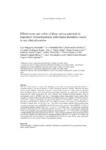Effectiveness and safety of direct‐acting antivirals in hepatitis C infected patients with mental disorders: results in real clinical practice

Use este enlace para citar
http://hdl.handle.net/2183/25372Coleccións
- Investigación (FCS) [1295]
Metadatos
Mostrar o rexistro completo do ítemTítulo
Effectiveness and safety of direct‐acting antivirals in hepatitis C infected patients with mental disorders: results in real clinical practiceAutor(es)
Data
2020-03-17Cita bibliográfica
Margusino‐Framiñán L, Bobadilla‐Pérez E, Cid‐Silva P, et al. Effectiveness and safety of direct‐acting antivirals in hepatitis C infected patients with mental disorders: results in real clinical practice. J Med Virol. 2020
Resumo
[Abstract]
The aim of this study is to analyze the effectiveness and safety of direct‐acting antivirals (DAAs) in psychiatric patients with chronic hepatitis C (CHC). Secondary objectives included adherence and drug‐drug interaction (DDIs) evaluations. Prospective observational comparative study carried out during 3 years. Psychiatric patients were included and mental illness classified by a psychiatric team based on clinical records. Main effectiveness and safety variables were sustained virologic response (SVR) at posttreatment week 12 (SVR12) and rate of on‐treatment serious drug‐related adverse events (AEs), respectively. A total of 242 psychiatric and 900 nonpsychiatric patients were included. SVR12 by intention‐to‐treat (ITT) analysis of psychiatric vs nonpsychiatric patients was 92.6% (95% confidence interval [CI], 89.1‐96.1) vs 96.2% (95% CI, 94.9‐97.5) (P = .02). SVR12 by modified‐ITT analysis was 97.8% (95% CI, 95.0‐99.3) vs 98.4% (95% CI, 97.5‐99.3) (P = .74). 92.2% of psychiatric patients with mental disorders secondary to multiple drug use (MDSDU) and 93.0% of psychiatric patients without MDSDU vs 96.2% of nonpsychiatric patients reached SVR12 (P = .05 and P = .20, respectively). The percentage of adherent patients to DAAs did not show differences between cohorts (P = .08). 30.2% of psychiatric patients and 27.6% of nonpsychiatric patients presented clinically relevant DDIs (P = .47). 1.7% vs 0.8% of psychiatric vs nonpsychiatric patients developed serious AEs (P = .39); no serious psychiatric AEs were present. DAAs have shown a slightly lower effectiveness in psychiatric patients with CHC, as a result of loss of follow up, which justifies the need for integrated and multidisciplinary health care teams. DAAs safety, adherence, and DDIs, however, are similar to that of nonpsychiatric patients.
Palabras chave
Chronic hepatitis C
Clinical research
Comparative effectiveness research
Direct‐acting antivirals
Drug safety
Mental disorder
Clinical research
Comparative effectiveness research
Direct‐acting antivirals
Drug safety
Mental disorder
Versión do editor
Dereitos
This is the peer reviewed version of the article which has been published in final form at Wiley Online Library. This article may be used for non-commercial purposes in accordance with Wiley Terms and Conditions for self-archving.
ISSN
0146-6615
1096-9071
1096-9071





